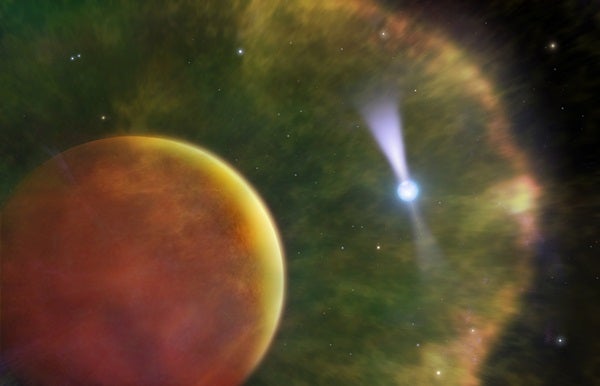But these exotic objects remain mysterious. Composed entirely of neutrons held up by the quantum mechanical principle that these particles cannot be compressed further, neutron stars are tiny in comparison with not only the average star, but also with Earth. Containing about 1.4 solar masses, these stellar corpses aren’t even as long as the largest dimension of Manhattan Island. But now, a team of astronomers has observed one of these extreme objects in unprecedented detail, spotting two regions of radiation only 12 miles (20 kilometers) apart around a neutron star sitting 6,500 light-years away. According to the study’s press release, that’s the equivalent of — without leaving Earth — seeing a flea on the surface of Pluto.
Their work, led by University of Toronto Ph.D. student Robert Main, was published today in Nature. The observation was made possible because of the particular system under scrutiny, which contains the pulsar B1957+20 and a brown dwarf, or failed star. B1957+20 is a “black widow” pulsar, which steals gas from its (in this case, sub)stellar companion, ultimately destroying it just as a black widow spider devours its mate. It spins more than 600 times a second, and previous studies indicate it may be one of the most massive pulsars ever discovered.
In this particular system, the brown dwarf, which is only about a third the diameter of our Sun, trails a wake of gas like a comet as it orbits B1957+20 at just 5 times the distance of the Moon from Earth. It is this gas that made the observation possible: “The gas is acting as like a magnifying glass right in front of the pulsar,” said Main. “We are essentially looking at the pulsar through a naturally occurring magnifier which periodically allows us to see the two regions [of radiation] separately.” These two regions are associated with two “hotspots” on the pulsar’s surface, which are in turn associated with its intense, lighthouse-like beams.

Want to learn more about pulsars and other extreme objects in our universe? Check out our free downloadable eBook: Exotic objects: Black holes pulsars, and more.
The system is an example of “plasma lensing,” in which gravitational lensing occurs in an area filled with plasma (in this case, the gas trailing the brown dwarf). This plasma lensing has magnified some of the pulsar’s radio emission by a factor of 70 to 80, massively boosting astronomers’ ability to observe these small, close-in regions. B1957+20 and its brown dwarf companion orbit each other every 9.2 hours, making it relatively easy to observe multiple lensing events every time the plasma trail and the pulsar line up from our point of view, so the team could build up a clear picture of the system.
Not only does this work offer a close-up look at an extremely interesting system, it also may shed light on one of astronomy’s hottest topics: fast radio bursts (FRBs). “Many observed properties of FRBs could be explained if they are being amplified by plasma lenses,” said Main. “The properties of the amplified pulses we detected in our study show a remarkable similarity to the bursts from the repeating FRB [121102], suggesting that the repeating FRB may be lensed by plasma in its host galaxy.”
Future plans to follow up this discovery, which was made with data from the Arecibo Observatory, are planned to better characterize the system.










